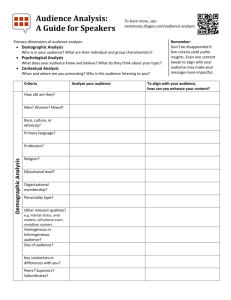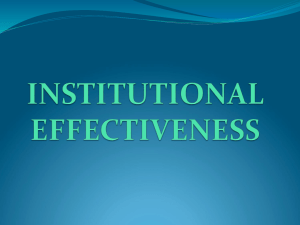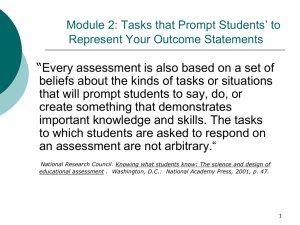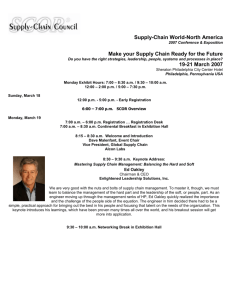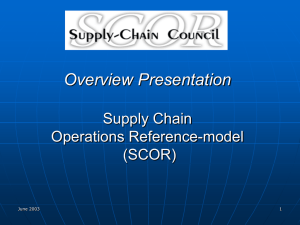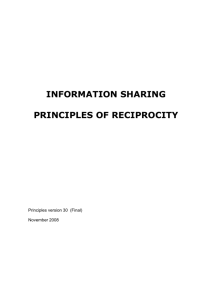Integrated Supply Chain Management with
advertisement
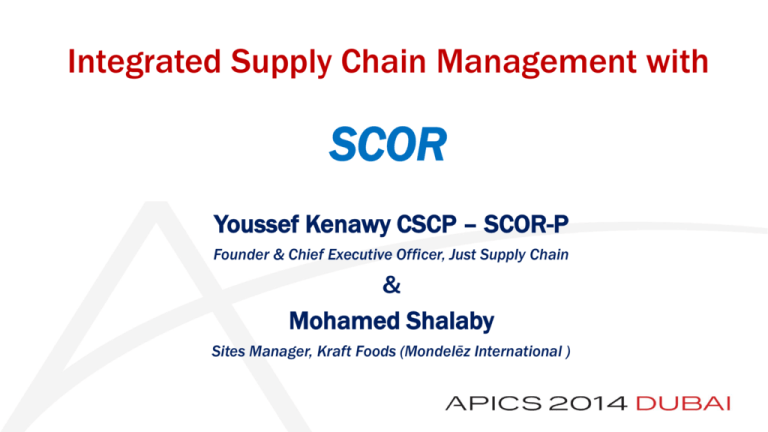
Integrated Supply Chain Management with SCOR Youssef Kenawy CSCP – SCOR-P Founder & Chief Executive Officer, Just Supply Chain & Mohamed Shalaby Sites Manager, Kraft Foods (Mondelēz International ) Agenda • What is Supply Chain about? • What is Integrated Supply Chain? • SCOR in brief • Integrated Supply Chain at Mondelez • Implementation Methodology A Bit of History: 1930-1950 • Bank Robber “Slick Willie” Sutton • When asked why he robbed banks, Sutton simply replied • "Because that's where the money is." Supply Chain is…not just about customer service, but is also about customer value creation, and…. …Where the Money Is • Supply-chain generally accounts for between 60% and 90% of all company costs1 • A 2% improvement in process efficiency for supply-chain processes has 3000% 5000% the impact of a 2% improvement in efficiency for… IT, HR, Finance1… Sales… • Most Process Methodologies or techniques had their origin primarily in SupplyChain Management? • Six-Sigma Lean BPR ERP ISO MRP-II TQM… Fortune-10 Company Supply-Chain Cost % Total Costs2 GM Ford Conoco Wal-Mart Chevron IBM Exxon GE 94% 93% 90% 90% 88% 77% 75% 63% 1 Exclusive of Financial Services companies 2 Source: Hoovers 2006 Financial Data, 2006 SCM Benchmark data on SCM cost for discrete & process industries 4 What’s Your Vision In Life ? Timothy D. Cook Future CEO’s ….. Integrated Supply Chain What’s Integrated Supply Chain? It’s a Supply Chain that Involves the change from managing the individual Functions of a business into an integrated process of value generation to formulate a business competitive advantage based on “Customer Value” management …. Why Integrated Supply Chain? 1- Generates Value Proposition for each Individual SKU 2- Increase Speed to Market 3- Reduce Total Cost 4- Establish Competitive Advantage 5- Make Tough Choices (Resilience & Collaborative Supply Chains) Features of Integrated Supply Chain Traditional SC Integrated SC - Focus on Product Innovation - Focus on Customer “Value” Proposition - Marketing driven business - ISC driven business Model - Sales is the focus point of operation - - Manufacturing and Supply Chain are looked on as Tool of Efficient Supply Marketing and Sales are Tools to evaluate Customer Need & Deliver Business Opportunities - Integrated Supply Chain is the Center of Gravity of the Business operations - Competitive advantages: Optimized Customer Value Management - Traditional Competitive advantages: Quality, Price, Availability … ect Integrated Supply Chain Evolution Before Supply Chain Supply Chain Transformation It Breaks the Silo’s between Functions and transforms the Flow of business – Chain of flow of Information - Goods - Money Traditional Supply Chain About SCOR – A Process Framework 10 • Combining 4 techniques into a single integrated approach Business Process Reengineering Capture the ‘as-is’ business activity and design the future ‘to-be’ state Performance Benchmarking Quantify relative performance of similar supply chains and establish internal targets Best Practices Analysis Identify practices and software solutions that result in significantly better performance Organizational Design Assess skills and performance needs and align staff and staffing needs to internal targets Process Reference Framework Processes Performance (metrics) Practices People (skills) About SCOR – Supply Chain 11 • Viewing a company as processes (domains) Product & Process Design Product Design DCOR™ Supply Chain SCOR ® Sales & Sales & Support Support CCOR™ CCOR™ Customer processes Supplier processes Product & Portfolio Product/Portfolio Management Management About SCOR – Supply Chain • SCOR defines supply chain as: “ The processes that plan and execute the acquisition of materials, transformation of materials in sellable products, delivery and return of products and services in support of customer orders ” Whether from Cow to Cone, Crude to Car or from Rock to Ring, SCOR is not limited by organizational boundaries SCOR can be applied to supply chains in any industry and to any organization in the chain Plan Deliver Return Source Return Plan Make Enable Suppliers’ Supplier Supplier Internal or External Deliver Return Source Return Make Deliver Return Enable Your Company Source Return Plan Make Deliver Return Source Return Enable Customer Internal or External Customers’ Customer Industry Membership Scope Integrated Supply Chain Evolution Before Supply Chain Supply Chain Transformation It Breaks the Silo’s between Functions and transforms the Flow of business – Chain of flow of Information - Goods - Money Traditional Supply Chain Integrated Supply Chain Evolution Integrated Supply Chain - Plan/ Source / Make & Deliver - At the heart of organizational business flow, focus on Customer Value Creation and Management - ISC Leads the transformation based on Business Enablers. - Business Strategy is set at ISC Strategy Workshops - ISC Leads The Orchestra of “Value Creation” Integrated Supply Chain Evolution - Mondelez Integrated Supply Chain Model - Leadership Transformation in (IL6S) on Learn/ DO/ Teach. - Build HPWS in Organizational Enablers (Right Structure & Right People on the Bus) - Shift the organization into a Skill Matrix Development Organization - Integrate SC Excellence & Lean - SN Pillar : Each Category & SKU has its own Finger Print that gets optimized by (SCOR) Concept. - Network Sourcing Design Integrated Business Planning Resilient Flow Supply Chain Evolution of Supply Network in Integrated Supply Chain The Challenge is in Collaboration and Multi-level Visibility and ISC Organization Structure That Shares Integrated Goals and Responsibility to drive “customer Value” management M4SC Management for Supply Chain Our Journey: M4SC Business Strategy Drives Segment business into supply chains, determine performance Drives Supply Chain Strategy Feedback Supply Chain Network Drives Manage processes towards strategic network goals Feedback Optimize network for strategic performance requirements Supply Chain Processes Drives Feedback Supply Chain Resources Feedback Continuously align resources to meet process goals M4SCاإلدارة لسالسل اإلمداد :رحلتنا يقود تجزئة األعمال في سلسلة االمداد وتحديد مستوى األداء يقود يقود شبكة سالسل اإلمداد إدارة العمليات نحو تحقيق أهداف الشبكة االستراتيجية يقود عمليات سالسل اإلمداد التغذية االسترجاعية التغذية االسترجاعية تحسين الشبكة لمتطلبات األداء االستراتيجي التغذية االسترجاعية موارد سالسل اإلمداد استراتيجية سلسلة اإلمداد استراتيجية األعمال التغذية االسترجاعية محاذات الموارد بشكل مستمر لتحقيق األهداف العملية Using SCOR in aligning supply chain performance with business objectives Align Strategy Align Strategy • Scope: Align supply chain goals and performance with business objectives and market needs • Horizon: 12-18 months to 5 years; Business Plan Scope • Outcomes: • Performance goals • List of performance gaps • Prioritized list of corrective actions Align Strategy Business Plan Analysis Supply Chain Segmentation Supply Chain SWOT Analysis Supply Chain Strategy Definition Supply Chain Data Collection Supply Chain Grouping Supply Chain RACI Analysis SCORcard Benchmarking Supply Chain Network Definition KPI RACI Analysis Supply Chain Prioritization Supply Chain Gap Analysis Using SCOR in aligning supply chain configuration and processes with performance objectives Align Network Align Network • Scope: Align the configuration of the supply chain network – suppliers, plants, warehouses, freight channels and customers - with supply chain performance objectives • Horizon: Month, Quarter, Year, Business Plan Scope • Outcomes: • Defined supply chain process configuration • Link between metric performance and processes • List of processes with performance gap contribution • Prioritized list of corrective actions Align Network Modules Supply Chain Network Definition Thread Diagram Network Metric Decomposition Network RACI Analysis Network Metric Prioritization Network Best Practices Analysis Network GRID Analysis Solution Definition Network Definition Network Change Prioritization Using SCOR in aligning how processes operate to meet performance requirements Align Processes Align Processes • Scope: Align process definition to network requirements • Frequency: Weekly, Monthly • Outcomes: • Defined process flows • Defined level-3 process performance requirements • Prioritized detailed changes to processes Align Processes Modules Process Flow Capture Process Data Capture Process Value Stream Model Process RACI Analysis Process Solution Definition Process To-Be Definition Process Best Practices Analysis Process Redesign Simulation Process Cycle Efficiency Analysis Process Business Rules Impact Process Organizational Impact Process Change Prioritization Using SCOR in aligning resources to meet performance and process design requirements Align Resources Align Resources • Scope: Align business resources to performance and process design requirements • Frequency: Daily, Weekly, Monthly • Outcomes: • Defined resource requirements • Prioritized people, process and technology changes • Authorization to commit resources Align Resources Modules Skills Capture Skills Resource Planning Procedures Capture Technology Capture Technology Resource Planning Organizational Review Program Resource Planning Resource Change Prioritization How to use SCOR in aligning supply chain performance with business objectives Align Strategy Align Strategy Business Plan Analysis Supply Chain Segmentation Supply Chain SWOT Analysis Supply Chain Strategy Definition Supply Chain Data Collection Supply Chain Consolidation Supply Chain RACI Analysis SCORcard Benchmarking Supply Chain Network Definition KPI RACI Analysis Supply Chain Prioritization Supply Chain Gap Analysis The Matrix • We now place the customer list as column headings repeating until finished • And then the products list as row headings repeating until finished • For each product that flows to a customer, we put an “X” in the cell • It’s that simple. Group 1 Customer A Product 1 Business 1 Group 2 Customer B Customer C Customer D X X Product 2 X X Product 3 X X Business 2 Product 4 X Example: Air Conditioning Company • Columns are Retail/Commercial, and sub-segmented • Rows are the Major Product Lines Customer/Market/Channels Retail Supply Chain Segmentation Matrix A Air Conditioners Lines of Business Product Families Big Box 1 Big Airco 2 Small Airco 3 Custom Industrial 4 Standard Industrial A2 B Commercial C D Internet Mom & Pop Building Direct Stores B1 B2 E F Major Account Distrib D1 F1 D3 D4 F3 C2 E4 Align Strategy Business Plan Analysis Supply Chain Segmentation Supply Chain SWOT Analysis Supply Chain Strategy Definition Supply Chain Data Collection Supply Chain Grouping Supply Chain RACI Analysis SCORcard Benchmarking Supply Chain Network Definition KPI RACI Analysis Supply Chain Prioritization Supply Chain Gap Analysis Strategy 6: SC Strategy Analysis • Definition • For each supply chain in an enterprise, we examine the priorities of their performance as required by internal and external customers. This constitutes the supply chain strategy. • We use a tool called the Strategic Analysis Matrix (SAM) to define the strategic priorities of a supply chain • Generally Part of Align Strategy • Predecessors • Supply Chain Segmentation Matrix • Hazards • Without clearly defined supply chains, strategies may create conflicting priorities in aggregate supply chains Strategy: Strategic Analysis Matrix (SAM) • We use a tool called the Strategic Analysis Matrix to Identify priority strategic features or attributes of Supply Chains. • Each supply chain strategy is indicated by a collection of ranked features, used to balance between external and internal priorities Reliability Responsiveness Agility Cost Assets On time? Complete? Undamaged? From Customer Request to final acceptance How long to scale up? How expensive to scale down? Cost of Processes? Cost of Goods Sold? Working Capital? Return on Investments? SAM Analysis Features Big Box Small Air Standard External • Choose at most Reliability P S Response P P A A Cost A A Assets S P Internal Agility • 1 “Superior” feature • 2 “Advantage” features • 2 “Parity” features • Can also choose simply 1 S/A Feature • Each unique combination of ratings defines Your Supply Chain Strategy for the channel • Ratings are a desired state, NOT where you want to improve the most • Should combine rational analysis of supply chain needs in market as well as SWOT opportunities Competitive Benchmarking • Relies on external, usually anonymized data source • Demographics must match size, planning model, region, and product scope of benchmarked supply chain • Generally requires submitting data to merge into master benchmark data set Attribute Metric (level 1) You Parity Adv Sup Gap Step 97% 85% 90% 98% 1% 1 Reliability S Perfect Order Fulfillment Response A Order Fulfillment Cycle Time 14 days 23 days 15 days 5 days 0 Days 0 Agility P Ups. Supply Chain Flexibility 62 days 63 days 62 days 60 days 0 Days 0 Cost P Supply Chain Mgmt Cost 12.2% 10.8% 10.4% 10.2% 1.4% 1 Assets A Cash-to-Cash Cycle Time 35 days 15 days 13 days 10 days 22 Days 2 Traditional Supply Chain Integrated Supply Chain
